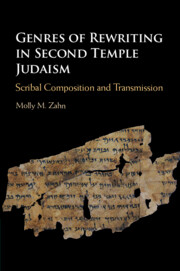
-
Select format
-
- Publisher:
- Cambridge University Press
- Publication date:
- June 2020
- June 2020
- ISBN:
- 9781108769983
- 9781108477581
- 9781108725750
- Dimensions:
- (228 x 152 mm)
- Weight & Pages:
- 0.52kg, 278 Pages
- Dimensions:
- (229 x 152 mm)
- Weight & Pages:
- 0.425kg, 278 Pages
You may already have access via personal or institutional login
Book description
In this book, Molly Zahn investigates how early Jewish scribes rewrote their authoritative traditions in the course of transmitting them, from minor edits in the course of copying to whole new compositions based on prior works. Scholars have detected evidence for rewriting in a wide variety of textual contexts, but Zahn's is the first book to map manuscripts and translations of biblical books, so-called 'parabiblical' compositions, and the sectarian literature from Qumran in relation to one another. She introduces a new, adaptable set of terms for talking about rewriting, using the idea of genre as a tool to compare and contrast different cases. Although rewriting has generally been understood as a vehicle for biblical interpretation, Zahn moves beyond that framework to demonstrate that rewriting was a pervasive textual strategy in the Second Temple period. Her book contributes to a powerful new model of early Jewish textuality, illuminating the rich and diverse culture out of which both rabbinic Judaism and early Christianity eventually emerged.
Reviews
‘… a significant contribution to the study of retelling, biblical hermeneutics, and material philology … This book moves the conversation about genre and rewriting to a new level as it is both theoretically sophisticated and philologically rigorous.’
Hindy Najman Source: Journal for the Study of the Old Testament
‘Leading us expertly through the labyrinth of 'rewriting,' Zahn analyses short texts/study cases as carefully and cleverly as she does broad, over-arching questions. One of her greatest achievements thus lies in allowing readers to see the forest and the trees alike. Adopting a variety of theoretical 'lenses' and discussing a variety of corpora (Dead Sea Scrolls, OG/LXX, Targumim) under 'one umbrella,' she hereby reveals that the “rewriting forest” is a dynamic, fascinating locus in which diverse species thrive.’
Atar L. Ivneh Source: Revue de Qumrân
Contents
Metrics
Altmetric attention score
Full text views
Full text views help Loading metrics...
Loading metrics...
* Views captured on Cambridge Core between #date#. This data will be updated every 24 hours.
Usage data cannot currently be displayed.
Accessibility standard: Unknown
Why this information is here
This section outlines the accessibility features of this content - including support for screen readers, full keyboard navigation and high-contrast display options. This may not be relevant for you.
Accessibility Information
Accessibility compliance for the PDF of this book is currently unknown and may be updated in the future.


